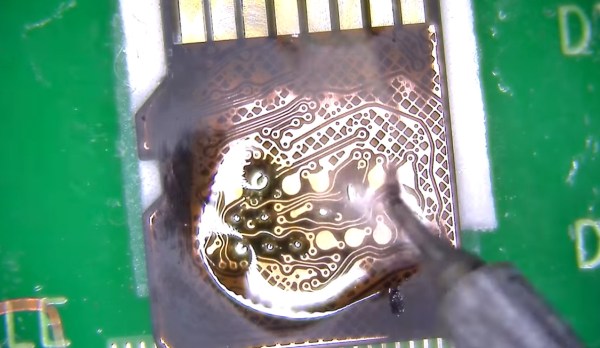If you lived through the Y2K fiasco, you might remember a lot of hype with almost zero real-world ramifications in the end. As the calendar year flipped from 1999 to 2000 many forecast disastrous software bugs in machines controlling our banking and infrastructure. While this potential disaster didn’t quite live up to its expectations there was another major infrastructure problem, resulting in many blackouts in North America, that reared its head shortly after the new millennium began. While it may have seemed like Y2K was finally coming to fruition based on the amount of chaos that was caused, the actual cause of these blackouts was simply institutional problems with the power grid itself.
Month: April 2017
Revealing Capcom’s Custom Silicon Security
Ask any security professional and they’ll tell you, when an attacker has hardware access it’s game over. You would think this easily applies to arcade games too — the very nature of placing the hardware in the wild means you’ve let all your secrets out. Capcom is the exception to this scenario. They developed their arcade boards to die with their secrets through a “suicide” system. All these decades later we’re beginning to get a clear look at the custom silicon that went into Capcom’s coin-op security.
Alas, this is a “part 1” article and like petulant children, we want all of our presents right now! But have patience, [Eduardo Cruz] over at ArcadeHacker is the storyteller you want to listen to on this topic. He is part of the team that figured out how to “de-suicide” the CP2 protections on old arcade games. We learned of that process last September when the guide was put out. [Eduardo] is now going through all the amazing things they learned while figuring out that process.
These machines — which had numerous titles like Super Street Fighter II and Marvel vs. Capcom — used battery-backed ram to store an encryption key. If someone tampered with the system the key would be lost and the code stored within undecipherable thanks to “two four-round Feistel ciphers with a 64-bit key”. The other scenario is that battery’s shelf life simply expires and the code is also lost. This was the real motivation behind the desuicide project.
An overview of the hardware shows that Capcom employed at least 11 types of custom silicon. As the board revisions became more eloquent, the number of chips dropped, but they continued to employ the trick of supplying each with battery power, hiding the actual location of the encryption key, and even the 68000 processor core itself. There is a 6-pin header that also suicides the boards; this has been a head-scratcher for those doing the reverse engineering. We assume it’s for an optional case-switch, a digital way to ensure you void the warranty for looking under the hood.
Thanks for walking us through this hardware [Eduardo], we can’t wait for the next installment in the series!
Recover Your Broken SD Card Selfies By Your Selfie
You may still have some luck getting those selfies off of your SD card, even if it will no longer mount on your computer. [HDD Recovery Services] shows us a process to directly access the NAND memory of a faulty micro SD card to recover those precious files you thought about backing up but never got around to.
On a Micro SD card you may have noticed there are two slightly longer pins than the rest. These are VSS and VCC pins. As long as they are not a dead short between the two the SD card controller isn’t completely trashed and we can go ahead and get into that little sucker. With a bit of know how — along with sandpaper, enameled wire, and a NAND reader — an image of your lost data can be recovered with a bit of patience and some good soldering skills.
Working your way down from a relatively high grit sand paper, slowly sand away the plastic on the underside of the SD card until you can clearly see the copper traces hidden away inside. Then solder your enameled wire onto the small solder pads to hook it up to a NAND reader and you should be able to read the data that was previously unreachable via conventional means. Of course you’re still going to need to make sense out of the NAND dump. That’s a topic for a different article.
If you ever find yourself in need of an SD card recovery tool you could always roll your own DIY NAND reader. We will likely give this process a try just to play round with the concept. Hopefully we’ll never need to do SD card recovery!
Continue reading “Recover Your Broken SD Card Selfies By Your Selfie”
Command Alexa With A Completely Mechanical Vintage Remote Control
Anyone with grandparents already knows that in ye olden days, televisions did not have remote control. Your parents probably still complain about how, as children, they were forced to physically walk over to the TV in order to switch between the three available channels. In these modern times of technological wonder, we have voice control, programmable touch screen remotes, and streaming services that will automatically play an entire season of the show you’re binge watching. However, before these, and before the ubiquitous infrared remote, television manufacturers were experimenting with ways to keep kids from having to run across the living room every time the channel needed to be changed.
Early remote controls were simply wired affairs — nothing too surprising there. But, it wasn’t long before methods of wireless control were being introduced. One early effort called the Flashmatic would shine light onto a photoelectric cell on the television set to control it. Of course, it might also be controlled by unintended light sources, and users had to have good aim to hit the sensor. These issues soon led to the introduction of the Zenith Space Command remote control, which used ultrasonic frequencies to control the TV.
Continue reading “Command Alexa With A Completely Mechanical Vintage Remote Control”
VCF: The Guys Keeping Up With Commodore
This year at the Vintage Computer Festival, war was beginning. The organizers of the con pulled a coup this year, and instead of giving individual exhibitors a space dedicated to their wares, various factions in the war of the 8-bitters were encouraged to pool their resources and create the best exhibit for their particular brand of home computers. The battle raged between the Trash-80 camp and the Apple resistance. In the end, only one home computer exhibit would remain. Are you keeping up with Commodore? Because Commodore is keeping up with you. This exhibit from [Anthony Becker], [Chris Fala], [Todd George], and [Bill Winters] among others is the greatest collection of Commodore ever assembled in one place.
This year’s Commodore exhibit was a free for all of every piece of the hardware Commodore (or Zombie Commodore) has ever produced. Remember netbooks? Commodore made one. Remember when people carried dedicated devices to play MP3s? Commodore was there. Did you know you can spend $20,000 USD on a 30-year-old computer? That’s Commodore.
Hackaday Links: April 2, 2017
Toorcamp registration is open. It’s June 20-24th on Orcas Island, Washington.
Hey, you. The guy still using Mentor Graphics. Yeah, you. Siemens has acquired Mentor Graphics.
CNC knitting machines are incredibly complicated but exceptionally cool. Until now, most CNC knitting machines are actually conversions of commercial machines. Beginning with [Travis Goodspeed] and [Fabienne Serriere] hack of a knitting machine, [Becky Stern]’s efforts, and the Knitic project, these knitting machines are really just brain transplants of old Brother knitting machines. A few of the folks from the OpenKnit project have been working to change this, and now they’re ready for production. Kniterate is a project on Kickstarter that’s a modern knitting machine, and basically a 2D woolen printer. This is an expensive machine at about $4500, but if you’ve ever seen the inside of one of these knitting machines, you’ll know building one of these things from scratch is challenging.
There was a time when a Macintosh computer could play games. Yes, I know this sounds bizarre, but you could play SimCity 2000, Diablo, and LucasArts adventure games on a machine coming out of Cupertino. [Novaspirit] wanted to relive his childhood, so he set up a Mac OS 7 emulator on a Raspberry Pi. He’s using Minivmac, beginning with an install of OS 7.1, upgrading that to 7.5.3, then upgrading that to 7.5.5. It should be noted the utility of the upgrade to 7.5.5 is questionable — the only real changes from 7.5.3 to 7.5.5 are improved virtual memory support (just change some emulator settings to get around that) and networking support (which is difficult on an emulator). If you’re going to upgrade to 7.5.5, just upgrade to 8.1 instead.
It’s getting warmer in the northern hemisphere, and you know what that means: people building swamp coolers. And you know what that means: people arguing about the thermodynamics of swamp coolers. We love these builds, so if you have a swamp cooler send it on in to the tip line.
The Prusa edition of Slic3r is out. The improvements? It’s not a single core app anymore (!), so slicing is faster. It’s got that neat variable layer slicing. Check out all the features.
It takes at least a week to delete your Facebook account. In the meantime, you can lawyer up and hit the gym. Additionally, we’re not really sure Facebook actually deletes your profile when you disable your account. Robots to the rescue. [anerdev] built a robot to delete all his content from Facebook. It’s a pair of servos with touchpad-sensitive pens. Add an Arduino, and you have a Facebook deleting machine.
The 35 Year Music Synthesizer That Spawned Chiptune
If you are a certain age, MOS6581 either means nothing to you, or it is a track from Carbon Based Lifeforms. However, if you were a Commodore computer fan 35 years ago, it was a MOS Technologies SID (Sound Interface Device). Think of it as a sound “card” for the computers of the day. Some would say that the chip — the power behind the Commodore 64’s sound system — was the sound card of its day. Compared to its contemporaries it had more in common with high-end electronic keyboards.
The Conversation has a great write up about how the chip was different, how it came to be, the bug in the silicon that allowed it to generate an extra voice, and how it spawned the chiptune genre of music. The post might not be as technical as we’d do here at Hackaday, but it does have oscilloscope videos (see below) and a good discussion of what it took to create music on the device.
Continue reading “The 35 Year Music Synthesizer That Spawned Chiptune”
















